Five years in and the Ultimate Universe is starting to look a little cluttered. In fairness, it was a little bit inevitable, with so many classic storylines to play out and so many classic characters to reimagine in a relatively short space of time. Bendis tries to keep the toys from cluttering up the pram through various means, and none of these new characters seem forced (though some do feel gratuitous). I suppose that if the Ultimate line is supposed to offer a mirror to the mainstream history of Marvel, it’s only natural it should become cluttered. Still, like playing with your favourite toys, it’s only natural to make a bit of a mess…

No claws for alarm...
None of this is to insinuate that Michael Bendis has lost his skill in writing Peter or ever loses focus on his core themes. It is just rather striking that a world which had seemed so grounded upon the launch of the series is now swamped with characters like Moon Knight and Hammerhead and Omega Red, among others. I don’t think that Bendis is fitting them in in order to ‘meet a quota’ (otherwise we’d have already met modern incarnations of even more classic Spider-man rogues like Mysterio or Tombstone), instead I think he knows the story he wants to tell and is using the characters who best fit that story. And – in fairness – Bendis himself highlights this trend in the final story in this collection The Talk, suggesting that this population boom in superpowered individuals is building towards something. I really hope it wasn’t Jeph Loeb killing them all.
I’ve said it before and I’ll likely say it again, but having a single writer in charge of property like this for half-a-decade has obvious advantages. The most obvious is that the entire saga feels like the same story, just with different threads flowing through it. Admittedly, the teenage angst of Peter Parker’s day-to-day school life is wearing a little thin after so many years, but the theme of underlying corruption within New York and the continuing ‘changing world’ threads remain as fascinating as ever.
I’ve admitted before that I’ve liked the way that everything in the Ultimate Universe fits together – rather than developing in an ad-hoc basis like the more organic elements of comic books did. In particular, I love the modernisation of the superhero origin – the are no longer children of the atom, but children of the genome. It’s equally hokey, but perfectly in step with the times.
It fits perfectly with a modern world just emerging from the threat of nuclear war and facing dilemmas like biological warfare, swine flu and human cloning. Sure, the books aren’t exactly subtle about the comparison between the two concepts – “the next war will be a genetic one” – but that’s part of the fun. The whole point of relaunching the series (apart from dumping ridiculously complicated continuity) is demonstrate that these fables still resonate and still mean something, which Bendis really does.
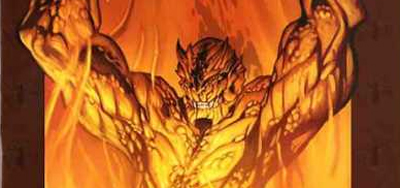
Surprisingly, he's NOT a good guy...
It’s accepted in the mainstream universe (and in the Sam Raimi films) that Norman Osborn is the webslinger’s greatest adversary – the indisputable king of the villains. Reading this collection (and Bendis’ work in general), I don’t think that this holds true here. Sure, Norman’s presence is felt here in the very first arc as his son attempts to reintegrate into society, and he continues to inflict great suffering on all those in anyway connected with him, but I don’t think Bendis really likes the costumed freak aspect of Spider-man’s rogues. Or maybe he just accepts how ridiculously impractical they are (so far one of the best features of this ‘definitive’ telling of the Spider-man mythos has been that death isn’t cheap – the freaks tend to meet violent ends and – for the most part – stay dead). I think that Bendis has positioned the Kingpin as Spider-man’s arch foe.
It works on a practical level – the Kingpin is never arrested, he’s never in any real physical danger, so the audience doesn’t wonder why he’s still around – but it really works on a thematic level. Most comic books stray into urban fantasy by having traditional and realistic threats to the city (mobsters, drug dealers, white-collar criminals) supplanted by crazies and nuts (look at the purging of Gotham’s criminal gangs in The Long Halloween and The Dark Knight, for example, to make room for “a better class of criminals”).
Bendis smartly turns the concept on its head. Yes, new mutants and superpowered nutjobs represent a risk (as Hammerhead does to Kingpin), but there is a reason that this kind of organisation has survived so long. While Bendis tied Peter Parker’s accident to Osborn, it’s Kingpin who defines Spider-man as an opposite. His cynicism and jaded world view contrasts with Peter’s youthful optimism. He doesn’t wear the bright colours of a supervillain, nor can he be trounced in a public battle – he’s insidious. He’s the one foe which Spider-man can’t beatdown and deliver to the cops.
He’s also, as an ordinary crook, a representation of the loss which Peter has suffered. There were no costumed crazies running around when his uncle was shot dead – it was done by an ordinary criminal, like the hundreds employed by this invisible organisation. For all the fantasy of throwing on a costume and fighting crime, Kingpin is more of a fundamental threat to society than Norman Osborn or Otto Octavius, for example. What Bendis gets at throughout his run, and in these collections in particular, is that Spider-man must be pretty ineffective if he can’t handle Fisk. Given that drug pushers are generally seen as the biggest excuse for vigilante justice by community action groups in the real world, it’s fair that Bendis makes him the centre here.
If the continued presence of Wilson Fisk represents the ineffectiveness of vigilante justice, surely it can demonstrate its effectiveness by removing him? What’s the point of putting on a mask and going outside the law if you can’t actually make a difference? The whole ‘lethal vigilante’ issue isn’t exactly new to comics, and the debate’s been had a million times before, but credit must be given for the skilled context used to frame the discussion this time around.
Bagley illustrates the world of Spiderman’s New York with bright shining colours, but Bendis writes in shades of grey, from the Punisher’s stark definition of black-and-white (Spider-man followed the advice of the Kingpin, therefore he works for him) to the darkening philosophy of Daredevil and Moon Knight as they realise just what they must do to get their ‘justice’. I think that Knights, the final arc in the volume where Bendis ties years of planning together to a surprisingly effective climax and conclusion, might represent Bendis’ finest work on the book (if the whole run is read as a single story) and a suitably high note for Bagley’s departure.
It’s interesting to see Bendis play with the origins and backgrounds of specific figures and characters and how they relate to their mainstream counterparts. Breaking Peter and MJ up was an inspired move, as was pairing him with Kitty Pride – actually developing the notion that if Mary-Jane can’t be safe around Peter, who could? It’s somewhat befitting that this collection features the Morbius vampire arc, as it perfectly represents the tightrope that Bendis finds himself walking when reimagining a complex mythology – and characters like Deadpool, for example – vampires are different from story-to-story. Sometimes a cross works, sometime is doesn’t; sometimes they need to be invited in, sometimes they can come and go as they please; sometimes they have to sleep in soil, other times simply in coffins or upside down; sometimes they can shapeshift, sometimes they can’t; and so on.
Yet, a vampire is a vampire. We recognise them from their core components: they drink blood and they hate sunlight. Anything else we can take or leave, depending on the saga before us. Bendis is doing something similar to the Marvel mythos – how far can he bend it before it becomes something completely different? To his credit, I admire his courage in experimenting with characters and plots. He succeeds more often than he fails. And, even when his reimaginings aren’t as successful as they might have been (during the Deadpool arc, for example), at least he is trying something new.
As with previous collections, it’s the small moments which really define Bendis’ work on the character. Little bits like yet another embarrassing defeat of Shocker (or, errr, Vibrator), the moment where the Black Cat discovers who is under her crush’s mask, a cute moment with Elektra and Spider-man in the lift, the revelation that the Kingpin literally owns Spider-man (through his rights) and a lovely sequence where Peter turns himself into the police after beating a suspect particularly hard, only to be given a sense of perspective by the officer. The series has always focused on Peter Parker and the little quirks and complex emotions that define his unconventional career.
That said, some of the more mundane concerns of Peter Parker’s life seem a little overdone. High school is a very difficult environment to write, and Bendis does it well, but there’s a note of repetition creeping in at this stage. To be fair, most of Peter’s scenes with Mary Jane are well-written and hammer home the humanity of the situation, but we get that high school is crap – we got that in the first year (or three). While Bendis’ conversations between young characters manage to avoid (for the most part) the pop culture desperation that defined Mark Millar’s writing on Ultimate X-Men, it still doesn’t seem as well-written as his conversations between adults (at the Daily Bugle, for example, or between Aunt May and Peter). Of itself, it’s a minor complaint, but – given how much time we spend with Peter in school – it is an irritating one.
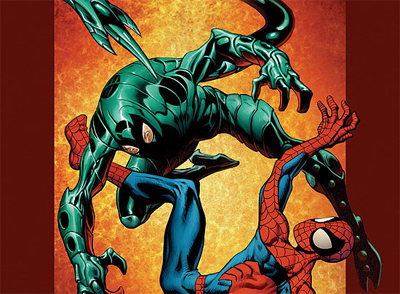
As you can imagine, there is a sting in the tale...
It’s also worth remarking upon how Bendis tries to keep his universe from becoming the crisscrossed and tangled mess that mainstream comics continuity became with 70-odd years of plots and characters. He’s been pretty thorough about killing off characters when he’s finished with them, which has a natural de-cluttering effect, as well as dealing with the old comic cliché of cardboard prisons and immunity for rogues, while also maximising the poignancy of certain encounters. Granted, Jeph Loeb would take this concept beyond its logical extreme with his own de-cluttering effort in Ultimatum, but here characters who have been declared dead have remained dead – also prison seems to be (generally) more effective (the Chameleon hasn’t reappeared since being put away, for example), and it’s somewhat surprising that Curt Connors hasn’t yet ‘relapsed’ as he is prone to do in the mainstream comics.
Here Bendis at least plays with the notions of comic book death and “ultimate” comic book death, first by bringing Hammerhead back from the dead (I believe he died in an X-Men special) only to dispose of him more thoroughly (ironically, by putting him in a coma), and he brings Gwen Stacy back (who, ironically, is one of the few mainstream continuity deaths to remain dead) only to reap even more tragedy from the vain hope that maybe death isn’t final – in the same arc Bendis teases us with the possibility that Peter’s father may be alive, but unfortunately dead is dead. It’s in playing with these conventions that Bendis demonstrates the strength of having a new universe created from scratch and intended to echo rather than literally mirror its counterpart. Setups and scenarios are designed to remind readers of what happened to the “real” Spider-man, but Bendis manages to subvert expectations enough to make his work on the title unpredictable – taking a classic concept and making it seem fresh and new.

Somewhat surprisingly, he IS a good guy...
The artwork from Mark Bagley continues to impress. Here he finishes his partnership with Bendis (apparently the longest working relationship in Marvel history), bowing out during the last issue. It’s hard to overstate how important his artwork was to the comic, giving it a consistent sheen and style over the best part of a decade. Nothing was ever blurred, distorted or unclear and Bagley was one of those few artists as skilled with kinetic movement as stationary objects. The collection is a fond farewell to his work on the title, which really can’t be overstated.
At this stage during the title’s lifecycle, the continuity and build-up are approaching critical mass, but the team of Bagley and Bendis manage to keep the momentum going, giving the impression that the web-slinger’s future is safe and well plotted-out. I still think that it would make sense to offer a definite end-date to the series, so Spider-man can enjoy a clean an ending in this medium, to compliment the clean start he was offered. Bendis manages to avoid some of the pitfalls that befall long-running titles, cleverly sidestepping the temptation to keep bringing characters back from the dead. The teenage melodrama may be a bit much at times, but, all-in-all, it’s a fun continuation to perhaps the most definitive take on the classic Marvel hero.
We have reviews up for all of Brian Michael Bendis’ run on Ultimate Spider-Man, in case you’re interested in checking it out, the rest can be found here:
- The Ultimate Spider-Man Collection (Hardcover Volumes #1-3)
- Ultimate Spider-Man (Hardcover Volumes #4-6)
- Ultimate Spider-Man (Hardcover Volumes #7-9)
- Ultimate Spider-Man (Hardcover Volumes #10-11)
Filed under: Comics | Tagged: brian michael bendis, clone saga, Comics, Deadpool, graphic novels, hobgoblin, Knights, mark bagley, marvel, marvel comics, Morbius, review, Silver Sable, spider man, spiderman, The Talk, ultimate clone saga, ultimate comics, Ultimate Deadpool, ultimate hobgoblin, ultimate marvel, Ultimate Morbius, Ultimate Silver Sable, ultimate spider man, ultimate spiderman, ultimate universe |


















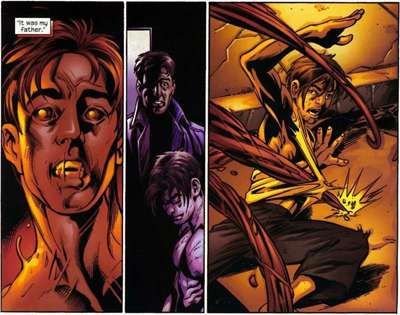
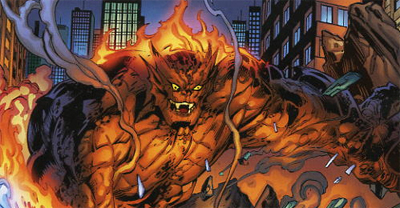
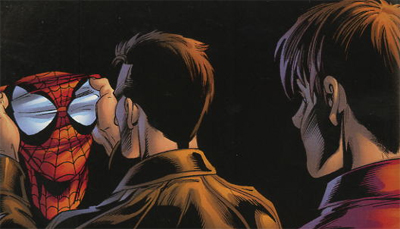





I agree Ultimate Knights is one of the best arcs, although Clone Saga- particularly the last issue where Octavius shows up- was pretty great. I disagree though that Fisk is Peter’s ultimate nemesis, and think you might have been basing that purely on that’s where this Omnibus ended and Bagley left, so it had a note of finality. In hindsight I think they should have had the Death of a Goblin arc be Bagley’s final arc, but I’m sure they would have done a lot of things had they known where the title was ultimately headed (and where Norman indeed became Peter’s biggest foe).